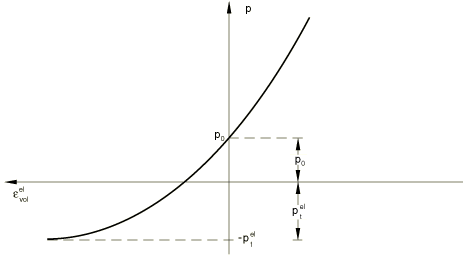Porous elasticity | ||
| ||
ProductsAbaqus/Standard
There are two types of porous elasticity models present in Abaqus/Standard: the logarithmic porous elasticity model and the power-law based porous elasticity model.
Logarithmic porous elasticity model
The model is based on the experimental observation that in porous materials during elastic (recoverable) straining, the change in the void ratio—e—and the change in the logarithm of the equivalent pressure stress—p—defined as
are linearly related, so that in rate form,
where is a material parameter. In this form the material has zero tensile strength. If the tensile strength is nonzero, the equivalent relation is
which includes the special case of zero tensile strength (). It can be shown that, if the compressibility of the solid material is neglected, the volume change of a material sample is
where is the initial void ratio. If we define the elastic void ratio from the elastic volume change according to the relationship
and then integrate the linear relation, the volumetric elasticity relationship is
where is the initial pressure stress, prescribed by initial conditions. Note that for a zero tensile strength material it is required that . This equation can be inverted to yield
as illustrated inFigure 1.

The deviatoric elastic behavior is defined either by choosing a constant shear modulus, G, so that the deviatoric elastic stiffness is independent of the equivalent pressure stress or choosing a constant Poisson's ratio, , so that the deviatoric elastic stiffness increases as the equivalent pressure stress increases. If a constant shear modulus is given, the deviatoric relationship is
whereas when Poisson's ratio is given, the relationship has the rate form
where
for a material with nonzero tensile strength. In these equations is the deviatoric stress:
and is the deviatoric part of the elastic strain:
where is the volumetric part of the elastic strain.
![]()
Power law–based porous elasticity model
In the case of the power law–based porous elasticity model, Young's modulus is related to the pressure by a power law:
where is the reference Young's modulus at pressure and and are material constants. is used to define the elastic modulus for tensile effective pressure and is calculated as follows:
Poisson's ratio is an exponential function of pressure
where is the value of the Poisson's ratio corresponding to the limit , is the value of the Poisson's ratio at , and is a material constant.